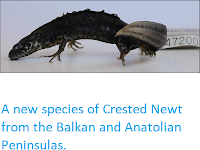In 1873-7 the French naturalist Henri Filhol published a series of
descriptions of 'mummified' animals from the Quercy region of southwest
France, which were actually external moulds of the animals preserved
in phosphatic clays within fissures on a limestone plateau.
Unfortunately Filhol did not accurately record the locations from which
these fossils originated, preventing accurate dating of individual
specimens, though the collection as a whole are thought to range
from Early Eocene to Early Miocene in age. In 2013 a a team of scientists led by Fabien Laloy of the Centre national de la recherche scientifique, the Muséum national d’histoire naturelle and the Université Pierre et Marie Curie published a paper in the journal PLoS One, in which a Frog from the Phosphorites du Quercy was shown to have preservation of not just its external morphology, but also of some internal structures, principally the skeleton, which were revealed by computerised tomography, which enabled the
formation of a three dimensional computer model of the specimen,
showing its internal structure.
In a paper published in the journal PeerJ on 3 October 2017, Jérémy Tissier of the Cenozoic Research Group at the JURASSICA Museum, and the Department of Geosciences at the University of Fribourg, and Jean-Claude Rage and Michel Laurin of the Département Histoire de la Terre at the Museum national d'Histoire naturelle, describe the results of a similar study of a large Salamander from the Quercy deposits, Phosphotriton sigei.
The specimen was shown to preserve part of the skeleton, particularly the spine, plus some muscle structure, some of the nervous system, including the spinal column and lumbosacral plexus, part of the digestive tract and the urogental organ.
Exceptional preservation of nerves, digestive tract and stomachal content. (A) and (B) 3D reconstructions of the pelvic section of Phosphotriton sigei, in laterodorsal (A) and ventral (B) views. The lumbosacral plexus (in blue) is partly preserved. Nerves exit the last trunk, the sacral and the first caudosacral vertebrae through the spinal nerve foramina. (C) Preserved bones of an Anuran Frog (Ranoid?), in green, inside the digestive tract. (D) Anuran humerus found inside digestive tract of Phosphotriton sigei, in lateral and ventral views. (E) Anuran vertebrae found inside digestive tract of Phosphotriton sigei. The centrum is very thin; the holes may represent segmentation artifacts. (F) 3D reconstruction of Phosphotriton sigei in ventral view, showing the nearly complete digestive tract. The caudal end is very close to the cloaca, and is bordered near the pelvic girdle by presumed dorsal cloacal glands (see Fig. 4A). (G) Virtual section of the trunk, showing the digestive tract (in yellow) and its content (frog bones).
The digestive tract contains a bone, interpreted as the humerus of a Frog, implying that the living Phosphotriton sigei, was a carnivore capable of tackling comparatively large prey. This is unusual in Salamanders which are predominantly insectivores today.
See also...
Follow Sciency Thoughts on Facebook.







